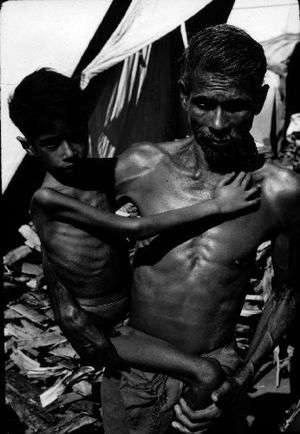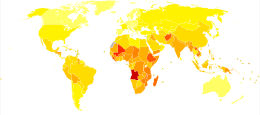Marasmus
Marasmus is a form of severe malnutrition characterized by energy deficiency. It can occur in anyone with severe malnutrition but usually occurs in children.[1] Body weight is reduced to less than 62% of the normal (expected) body weight for the age.[2] Marasmus occurrence increases prior to age 1, whereas kwashiorkor occurrence increases after 18 months. It can be distinguished from kwashiorkor in that kwashiorkor is protein deficiency with adequate energy intake whereas marasmus is inadequate energy intake in all forms, including protein. This clear-cut separation of marasmus and kwashiorkor is however not always clinically evident as kwashiorkor is often seen in a context of insufficient caloric intake, and mixed clinical pictures, called marasmic kwashiorkor, are possible. Protein wasting in kwashiorkor generally leads to edema and ascites, while muscular wasting and loss of subcutaneous fat are the main clinical signs of marasmus.[3]
| Marasmus | |
|---|---|
 | |
| Child with Marasmus in Nepal, 1972 | |
| Specialty | Critical care medicine |
| Complications | onset |
The prognosis is better than it is for kwashiorkor[4] but half of severely malnourished children die due to unavailability of adequate treatment.
The word “marasmus” comes from the Greek μαρασμός marasmos ("withering").
Signs and symptoms

Marasmus is commonly represented by a shrunken, wasted appearance, loss of muscle mass and subcutaneous fat mass.[5] Buttocks and upper limb muscle groups are usually more affected than others. Edema is not a sign of marasmus and is present in only kwashiorkor and marasmic kwashiorkor. Other symptoms of marasmus include unusual body temperature (hypothermia, pyrexia); anemia; dehydration (as characterized with consistent thirst and shrunken eyes); hypovolemic shock (weak radial pulse; cold extremities; decreased consciousness); tachypnea (pneumonia, heart failure); abdominal manifestations (distension, decreased or metallic bowel sounds; large or small liver; blood or mucus in the stools), ocular manifestations (corneal lesions associated with vitamin A deficiency); dermal manifestations (evidence of infection, purpura, and ear, nose, and throat symptoms (otitis, rhinitis). Dry skin and brittle hair are also symptoms of marasmus. Marasmus can also make children short-tempered and irritable.[6]
Causes
Marasmus is caused by the following factors:
- Maternal malnutrition
- Maternal anemia
- Parental ignorance
- Poverty
- Pathological conditions in a baby (e.g., diarrhea)
- Pneumonia
- Cyanotic heart diseases
- Malaria
- Necrotizing enterocolitis
- Pyloric stenosis
- Lactose intolerance
- Intussusception
- Meningitis
Treatment
Both the causes and complications of the disorder must be treated, including infections, dehydration, and circulation disorders, which are frequently lethal and lead to high mortality if ignored. Initially, the child is fed dried skim milk that has been mixed with boiled water. Once the child tolerates the milk, a vegetable mix can be added including sesame, casein, and sugar. [7] Refeeding must be done slowly to avoid refeeding syndrome. Once children start to recover, they should have more balanced diets which meet their nutritional needs. Children with marasmus commonly develop infections and are consequently treated with antibiotics or other medications.[8] Ultimately, marasmus can progress to the point of no return when the body's ability for protein synthesis is lost. At this point, attempts to correct the disorder by giving food or protein are futile.
Epidemiology
United States
In the United States, marasmus is rarely seen, especially in children. In 1995, there were only 228 deaths caused by marasmus in the U.S., of which only 3 were children. In 2016, the prevalence of marasmus in the United States was 0.5%. Prevalence is higher in hospitalized children, especially ones with chronic illnesses, however an exact incidence of nonfatal marasmus is not known. This is due to marasmus not being reported as an admission or discharge diagnosis.[9]
International
There are multiple forms of malnutrition and roughly 1/3 of the world’s population is currently experiencing one or more of them. There are around 50 million children less than 5 years old who have protein-energy malnutrition. Of the malnourished children population in the world, 80% live in Asia, 15% in Africa, and 5% in Latin America. It is estimated that the prevalence of acute malnutrition in Germany, France, the United Kingdom, and the United States to be 6.1-14%. In Turkey, the prevalence is as high as 32%.[9]
Race
There is no evident racial predisposition that correlates to malnutrition. Rather, there is a strong association with the geographic distribution of poverty. [10]
Age
Marasmus is more commonly seen in children under the age of 5 due to that age range being characterized as one that has an increase in energy need and susceptibility to viral and bacterial infections. [11] The World Health Organization also identifies the elderly as another population that is vulnerable to malnutrition. Because their nutritional requirement is not well defined, attempts to provide them with the necessary nutrition becomes difficult. [12]
There exists screening tools and tests that can be used to help identify signs and symptoms of malnutrition in older adults. The Malnutrition Screening Tool (MST) is a validated malnutrition screening tool that is primarily used in the residential aged care facility or for adults in the inpatient/outpatient hospital setting. It includes parameters such as weight loss and appetite. [13]

Persons in prisons, concentration camps, and refugee camps are affected more often due to poor nutrition.
See also
References
- "What You Should Know About Marasmus". Healthline.
- Appleton & Vanbergen, Metabolism and Nutrition, Medicine Crash Course 4th ed. Moseby (London: 2013) p.130
- Müller, Olaf; Krawinkel, Michael (2005-08-02). "Malnutrition and health in developing countries". CMAJ : Canadian Medical Association Journal. 173 (3): 279–286. doi:10.1503/cmaj.050342. ISSN 0820-3946. PMC 1180662. PMID 16076825.
- Badaloo AV, Forrester T, Reid M, Jahoor F (June 2006). "Lipid kinetic differences between children with kwashiorkor and those with marasmus". Am. J. Clin. Nutr. 83 (6): 1283–8. doi:10.1093/ajcn/83.6.1283. PMID 16762938.
- Rabinowitz, Simon. "MD, PhD, FAAP". Emedicine Medscape. Medscape. p. 28. Retrieved 29 January 2015.
- "What You Should Know About Marasmus". Healthline.
- "What You Should Know About Marasmus".
- "What You Should Know About Marasmus". Healthline.
- "Marasmus: Background, Pathophysiology, Body Composition". 2019-02-02. Cite journal requires
|journal=(help) - Stephens, Janna D.; Althouse, Andrew; Tan, Alai; Melnyk, Bernadette Mazurek (2017). "The Role of Race and Gender in Nutrition Habits and Self-Efficacy: Results from the Young Adult Weight Loss Study". Journal of Obesity. 2017: 5980698. doi:10.1155/2017/5980698. ISSN 2090-0708. PMC 5406727. PMID 28491474.
- Katona-Apte, Judit; Katona, Peter (2008-05-15). "The Interaction between Nutrition and Infection". Clinical Infectious Diseases. 46 (10): 1582–1588. doi:10.1086/587658. ISSN 1058-4838. PMID 18419494.
- "WHO | Nutrition for older persons". WHO. Retrieved 2019-08-07.
- "Malnutrition Screening and Assessment Tools". NCOA. 2017-01-20. Retrieved 2019-08-07.
- "Mortality and Burden of Disease Estimates for WHO Member States in 2002" (xls). World Health Organization. 2002.
External links
| Classification | |
|---|---|
| External resources |